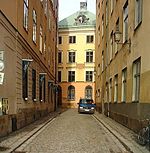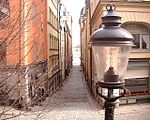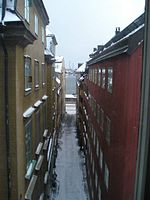Drakens Gränd

Drakens Gränd is an alley in Gamla stan, the old town of Stockholm, Sweden. Stretching from Skeppsbron to Österlånggatan, it forms a parallel street to Stora Hoparegränd and Ferkens Gränd. It appears in historical records as Bredgränd (?), brede gränden (?), Makelerens gränd (17th century, after a Jacob Mac Leer), Bergsgränd (1686), Drakens gr[änd] (1728), Skultans gränd (?)The alley is named after the tavern Draken ("The Dragon") once found in the western end of the street. During the 1660s it was owned by a Melchior Schipman; in 1682 bought by Jöran Berg and renamed Förgyllda Draken ("Gilded Dragon"); and finally discontinued after the latter's death in 1722.The proletarian author Erik Asklund (1908–1980) wrote the novel Drakens gränd in 1965 as part of a trilogy.Drakens gränd is also the name of a company owned by King Carl XVI Gustav (1946-). The company appeared in Swedish media in early 2006, as a property in the alley owned by the king featured in transactions for which the king was accused of tax avoidance.
Excerpt from the Wikipedia article Drakens Gränd (License: CC BY-SA 3.0, Authors, Images).Drakens Gränd
Drakens Gränd, Stockholm Gamla stan (Södermalms stadsdelsområde)
Geographical coordinates (GPS) Address External links Nearby Places Show on map
Geographical coordinates (GPS)
| Latitude | Longitude |
|---|---|
| N 59.324444444444 ° | E 18.07475 ° |
Address
Drakens Gränd
Drakens Gränd
111 31 Stockholm, Gamla stan (Södermalms stadsdelsområde)
Sweden
Open on Google Maps









